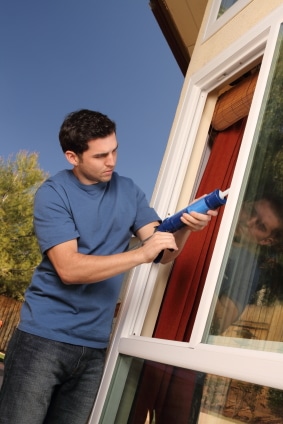 Sealing air leaks in your home can help you reduce monthly utility bill costs by preventing cooled or heated air inside from escaping outside and cool or warm outside air from making its way inside. If you’re a do-it-yourselfer, the first step in sealing air leaks in your home is choosing the right kind of caulking compound for your gap- or crack-sealing job. The next step is getting some good advice about how to apply caulk effectively so that it seals tight, looks professional, and doesn’t turn into a mess. Here are a few tips to help you do just that:
Sealing air leaks in your home can help you reduce monthly utility bill costs by preventing cooled or heated air inside from escaping outside and cool or warm outside air from making its way inside. If you’re a do-it-yourselfer, the first step in sealing air leaks in your home is choosing the right kind of caulking compound for your gap- or crack-sealing job. The next step is getting some good advice about how to apply caulk effectively so that it seals tight, looks professional, and doesn’t turn into a mess. Here are a few tips to help you do just that:
- Remove any old caulk and paint residue using a putty knife, stiff brush, or solvent.
- For best adhesion, thoroughly clean all areas to be caulked and then dry completely before applying new caulking compound so moisture doesn’t get sealed in and damage the caulk later on.
- When applying caulk, hold the caulking gun at a 45-degree angle. Doing so allows the caulk to get deep into the crack. If you’re holding the caulking gun at the correct angle, the caulking compound should be immediately forced into the crack or gap as soon as it comes out of the tube.
- Make sure to apply the caulk in one straight, continuous line whenever possible. Stop and starts should be avoided, as they allow seams in the caulk that may become evident or decrease the strength of the seal when then the compound shrinks.
- Send caulking compound to the bottom of a gap, crack or seam first, in order to create the tightest, most complete seam and avoid bubbles.
- Make sure you apply enough caulk. You can always clean off any extra you dont need. Without going overboard, use enough caulk to fill gaps and cracks. If the caulk shrinks, reapply caulk to seal the crack or gap completely.
- Ensure that the caulk sticks to both sides of a crack or seam.
- When applying caulk, release the trigger on the caulking gun before you pull it away from the gap, crack or seam to avoid applying too much caulking compound. This can be accomplished easily by using a caulking gun with an automatic release.
- Have a putty knife on hand when applying caulk. If caulking compound starts to ooze out of a crack, use the putty knife to push it back in.
- When sealing a window, apply caulk to all joints in the frame and the joint between the frame and the wall.
Note: The best time to apply caulk is during dry weather when the outdoor temperature is above 45ºF (7.2ºC). Low humidity will prevent cracks and warm temperatures will help the caulk set and adhere to the material.
These tips should make any do-it-yourselfer a veritable pro when it comes to applying caulk. If you’re wondering what kind of caulking compound to use for a particular job, check out part one of our discussion, where we cover choosing the right caulk to seal air leaks in your home.
Sources
U.S. Department of Energy, Caulking.



